
Tarski’s World
(Last updated December 07, 2025)
Enjoy my silly design adventures and mistakes below!
- Tarski’s World
- What is this?
- Parsing and interpreting First Order Logic (FOL)
- Model, View, Controller
- World (model, data) design
- Interpreter
- Controller
- Reactor: a guide
- Mouse input
- Converters
- Grid positions
Posand coordinate positionsPoint - Converting from Pos to Point
- Converting from Point to Pos
- Conditional givens, extension methods
- Converting conditionally with givens: an anti-pattern
- Deferred givens? No, just regular old parameters
- Ad-hoc (typeclass) vs. subtype (inheritance) polymorphism
- Grid positions
- Handlers
- View
- Adding package boundaries to find dependency problems
- Moving from Doodle to ScalaFX, proper UI
- Exposing the library to users
- Issue with smaller screen sizes
- First approach: make
Sizeagiven, then use conditional givens - Second approach: change
Sizeto use an implicitScaleFactor - Understanding the problem a bit better
- A “singleton object with an implicit parameter”?
- Third approach: create a
Constantsclass - A trick: singleton object plus extension methods
- Too many extension methods
- Final approach: use a combination of approaches
- Silly fun with different rows and columns
- First approach: make
- Import / export issues
- Font issues
- Issue with smaller screen sizes
- Finally releasing the damn thing into the wild
- Companion repository
- What’s next
- Work in progress
What is this?
Recreating Barwise and Etchemendy’s Tarski’s World in Scala and Doodle. (I might switch to ScalaFX later.)
So far I have a crude approximation, but most code logic is in place:
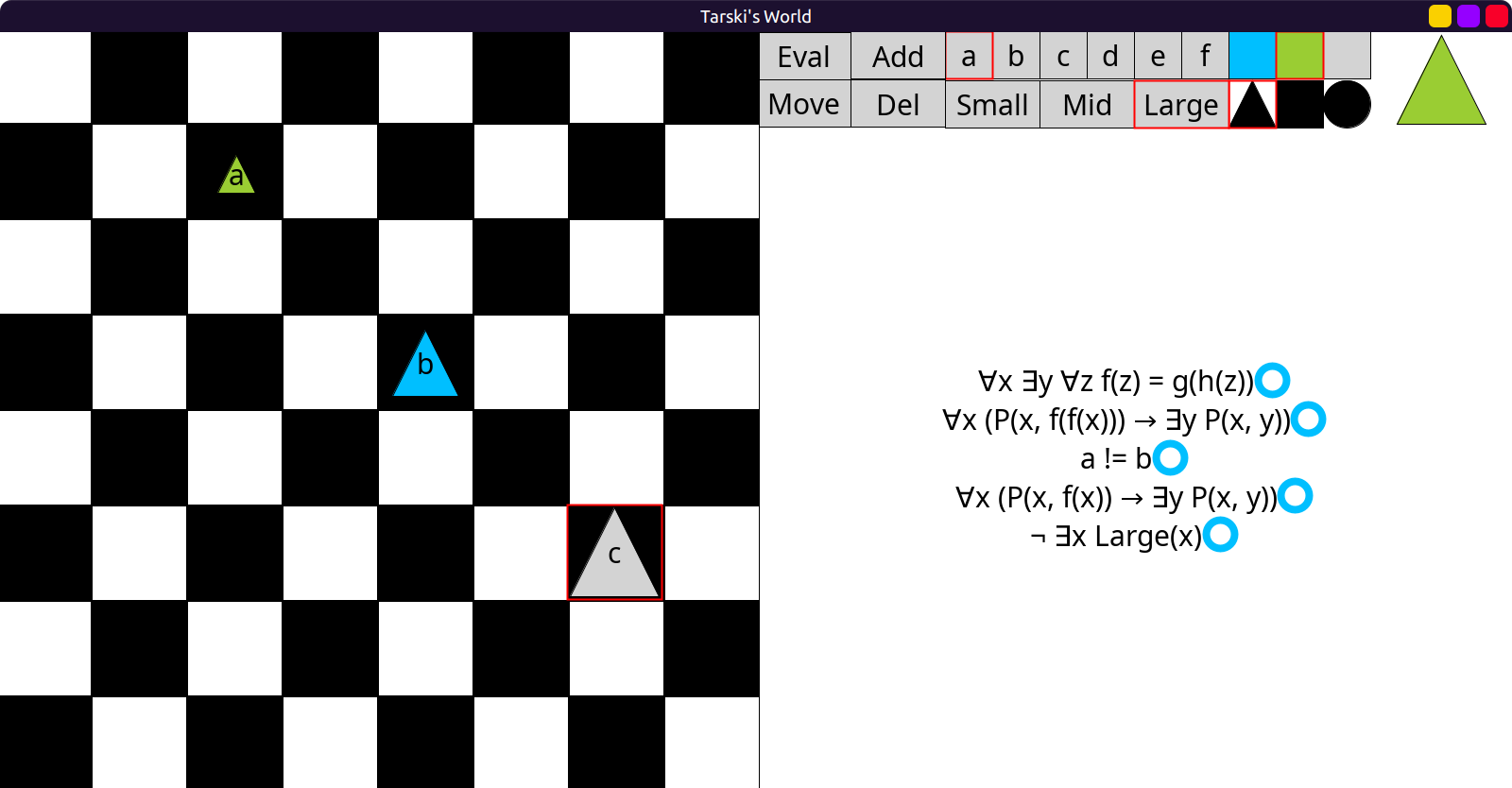
Who is Tarski?
Alfred Tarski was one of the most influential logicians of the 20th century. He is known for his work on model theory (semantics) of first order logic: defining the concept of a model, and truth in a model.
Approach
Many of the early decisions I made are deliberately poor choices. For example, I started making a UI in a library that does not have any UI features. My purpose is to learn along the way and keep breaking things.
Parsing and interpreting First Order Logic (FOL)
In the finished program, users would be able to manually enter first order formulas like
¬(∃x Large(x)) into text boxes, which would then be evaluated.
This meant that I had to deal with bad user input: missing / wrong parentheses,
quantifiers with missing variables, wrong use of logical connectives, and so on.
Crude attempt at self-parsing
The original Tarski’s world had some predicate symbols about the shapes, sizes and
placement of objects. Like: FrontOf(x, y), Cube(x), Small(y) etc.
It had restricted named objects to a-f and variables to u-z.
So I started making a FOL grammar:
enum Var:
case U, V, W, X, Y, Z
enum Name:
case A, B, C, D, E, F
type Term = Var | Name
enum Atomic:
case Small(t: Term)
case Medium(t: Term)
case Large(t: Term)
case Circle(t: Term)
case Triangle(t: Term)
case Square(t: Term)
case Blue(t: Term)
case Black(t: Term)
case Gray(t: Term)
case LeftOf(t1: Term, t2: Term)
case RightOf(t1: Term, t2: Term)
case FrontOf(t1: Term, t2: Term)
case BackOf(t1: Term, t2: Term)
case Adjoins(t1: Term, t2: Term)
case Smaller(t1: Term, t2: Term)
case Larger(t1: Term, t2: Term)
case Same(t1: Term, t2: Term)
case SameSize(t1: Term, t2: Term)
case SameShape(t1: Term, t2: Term)
case SameColor(t1: Term, t2: Term)
case SameRow(t1: Term, t2: Term)
case SameCol(t1: Term, t2: Term)
case Between(t1: Term, t2: Term, t3: Term)
enum Formula:
case Atom(a: Atomic)
case Not(f: Formula)
case And(f1: Formula, f2: Formula)
case Or(f1: Formula, f2: Formula)
case Implies(f1: Formula, f2: Formula)
case Bicond(f1: Formula, f2: Formula)
case Forall(v: Var, f: Formula)
case Exists(v: Var, f: Formula)
The issue of free variables and substitution
Now this is already hard enough.
Normally, FOL has more complex terms that can use function symbols, so if a,b,c are
named objects and x,y,z are variables you could have complex terms like:
f(x, a, g(y, z, c), b). This would be a nightmare for my stupid skills to deal with.
Thankfully Tarski’s world has no function symbols, only bare atomic formulas,
quantifiers and logical connectives.
But, due to quantifiers and variables, there was still the issue of free variables.
I would have to figure out which occurrences of a variable were free,
so that when I’m evaluating a formula like ∃x(some formula)
I would have to “peel off” the quantifier, then “plug-in” named objects for the variable:
some formula(x = a) only in the correct places for x.
I even tried to do property testing by generating formulas with ScalaCheck:
package tarski
package testing
import org.scalacheck.{Gen, Test, Prop}
val varGen = Gen.oneOf[Var](Var.values)
val nameGen = Gen.oneOf[Name](Name.values)
val termGen = Gen.oneOf[Term](varGen, nameGen)
val atomFreeGen =
for
vari <- varGen
t1 <- termGen
t2 <- termGen
yield (vari, Seq(Medium(vari), LeftOf(vari, t1), Between(vari, t1, t2)))
val atomNonFreeGen =
for
vari <- varGen
t1 <- termGen
t2 <- termGen
t3 <- termGen
if vari != t1 && vari != t2 && vari != t3
yield (vari, Seq(Medium(t1), LeftOf(t1, t2), Between(t1, t2, t3)))
package tarski
package testing
import org.scalacheck.Prop.forAll
class AtomicSuite extends munit.FunSuite:
test("atomic formulas (1, 2, 3-ary) with a free variable"):
forAll(atomFreeGen): (vari, atoms) =>
atoms.forall(_.hasFree(vari))
test("atomic formulas (1, 2, 3-ary) without a free variable"):
forAll(atomFreeGen): (vari, atoms) =>
atoms.forall(!_.hasFree(vari))
This is pretty tricky to do; I was always trying to get away with a surface level effort and an “idiot’s approach”, but it was clear that this was going to require more theory.
Giving up and exploring much better options: enter GAPT
I caved and started looking for out-of-the-box FOL parsers. So grateful that Gapt existed already! Thanks, Vienna University of Technology!
Syntax (proofs) and semantics (world)
This library is incredibly well put together and can handle all kinds of provers, solvers and the like, even for higher-order logics. However, this is purely in the syntactic realm of logic; concerned with symbolic proofs. Tarski’s world is about semantics instead: the interpretation of formulas in a concrete world with objects and values.
So I am using a tiny portion of Gapt’s true power; only for parsing.
Out-of-the-box parsing
It has excellent built-in parsing support with string interpolators, for example:
val F = fof"!x (P(x,f(x)) -> ?y P(x,y))"
val t = fot"f(f(x))"
val G = fof"!x (P(x,$t) -> ?y P(x,y))"
val H1 = hof"!x?y!z x(z) = y(y(z))"
val H2 = hof"∀x ∃y ∀z x(z) = y(y(z))"
Here fof is “first order formula”, fot is “first order term” and
hof is “higher order formula”. Notice the interpolated $t inside a string.
! and ? are alternative syntax for ∀ “for all” and ∃ “there exists”.
But it also allows full pattern matching all the way down to the atoms:
val e = fof"¬(∃x Large(x))"
e match
case Neg(Ex(FOLVar("x"), FOLAtom("Large", List(FOLVar("x"))))) => println("yay!")
// prints yay!
Model, View, Controller
This “model” is not the same as the “model” from Logic above, but conceptually similar.
The initial stage of my repository was just all over the place and disorganized. The only “structure” I had so far was the grammar:
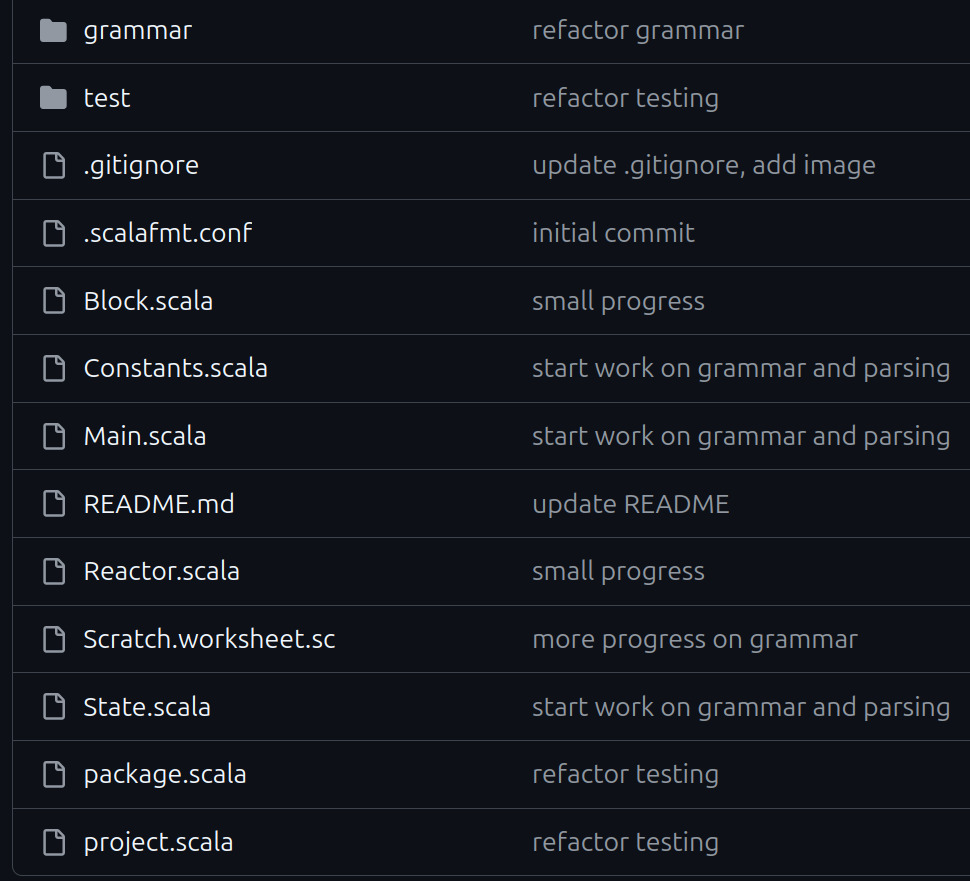
Then I remembered this thing.
Of course I did no reading or research. Instead I started thinking about it naively. To me it seemed like Controller was simply the “glue” between Model and Controller. “Could it really be that simple? There’s gotta be more to it than that”, I thought.
I reorganized the repository, at this point I still have grammar but no controller yet:
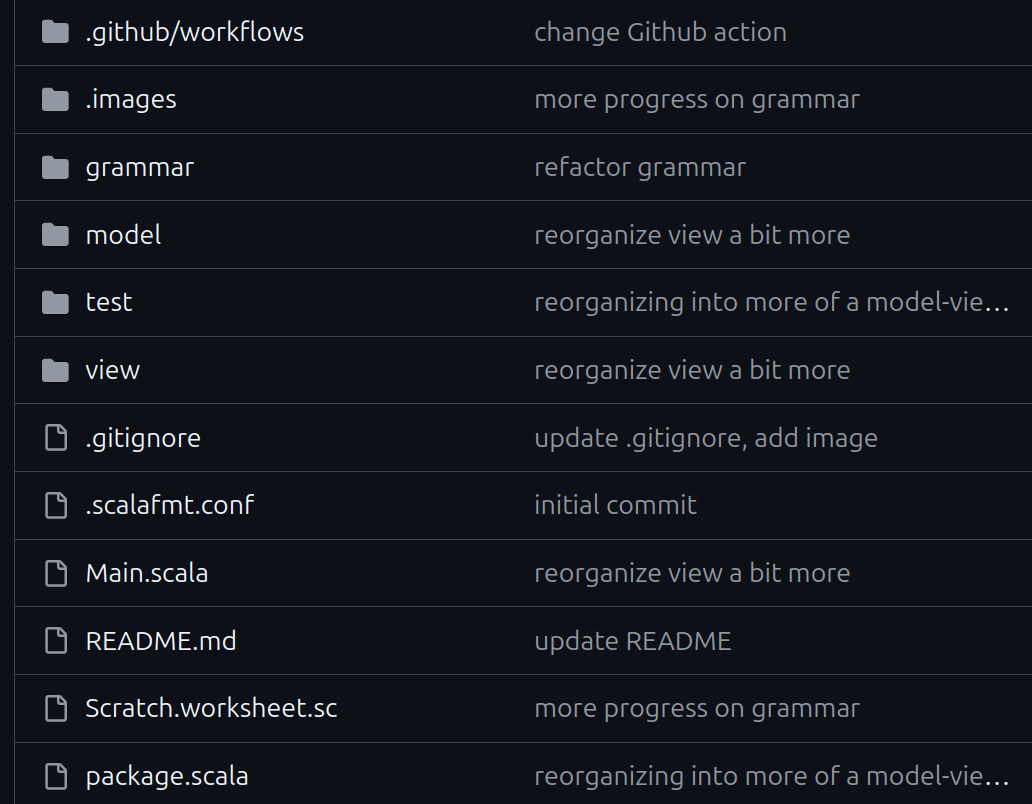
Data: model or view? It’s philosophical
The original Tarski’s world software actually does have two different “views”:
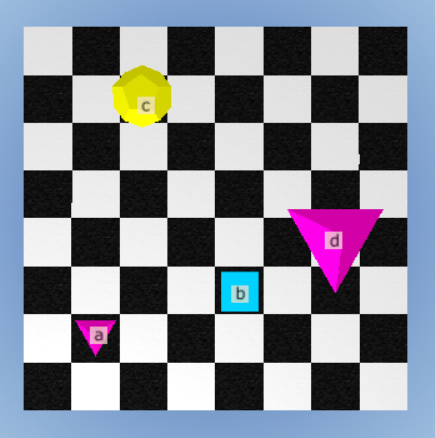
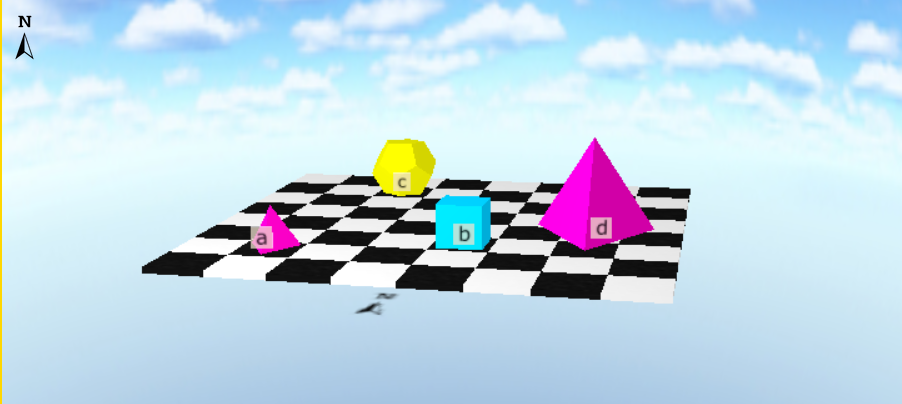
But I am not interested in the 3D view; not only it’s very difficult to implement, but it is also not very usable, making it hard to see objects and locations well.
So what does “view” mean for me in this case?
It’s got something to do with… visuals, right? I have a Block class:
case class Block(
size: Double, // Small, Medium, Large
shape: Shape, // Tri, Squ, Cir
color: Color, // Blue, Black, Grey
label: String = ""
)
That’s all visual stuff, so it should be in the View right?
But wait, isn’t this just data? So it should be part of the Model then?
It gets philosophical: what if the Model needs to hold data that is visual?
Because the actual logic of the program in this case
depends on the size / color / shape of the objects.
This Block class is a place where data and visuals merge into one thing.
I am working on a very weird special case here!
Ideally, to serve multiple views, the Model should have just one kind of data, which is then translated to multiple visual elements. So the size / color / shape would be the “one data”.
I could duplicate the Block class in Model and View,
call it BlockData and BlockView or something.
So BlockData would be just the “data”, then BlockView would be “how it looks”. 😄
Or, just move Block into Model, then let the View just handle the rendering?
There is more to think about. How the formulas will be rendered, for example! Should that also go into Model? Then everything moves into Model, and View is mostly empty.
Should there be a 1-1 correspondence between Model and View for every piece of data?
BlockData <-> BlockView, Formula <-> FormulaView and so on?
The fact is that it’s actually quite simple to convert a Block or a Formula
to an image, so that it seems redundant / overkill design to duplicate classes.
I have to draw the line somewhere and make a decision…
No consensus out there
Seems like even in the broader software world there really is no consensus. There are many variants like model-view-presenter, model-view-adapter, model-template-view, and even… model-view-viewmodel! 🤣 Yeah, sure guys. Dana Moore says in “Professional Rich Internet Applications: Ajax and Beyond (2007)” that
“Since the origin of MVC, there have been many interpretations of the pattern. The concept has been adapted and applied in very different ways to a wide variety of systems and architectures.”
So I believe I do have permission to interpret things in my own way. I mean, all this software design / pattern / architecture stuff can get very vague. Without pinning it down to a specific problem and seeing what comes up, it’s impossible to adhere to some predetermined pattern and its “laws”.
In fact, even the names of the components are used differently. For example, in Django, Controller is called “view” and View is called “template”: Django FAQ
To quote them on this issue:
Well, the standard names are debatable. In our interpretation of MVC, the “view” describes the data that gets presented to the user. It’s not necessarily how the data looks, but which data is presented. The view describes which data you see, not how you see it. It’s a subtle distinction.
I do have to admit, this stuff gets very philosophical! If I say “this block is blue”, is that “what you see” or “how you see it”? The data itself (blue) is a visual thing, kind of…
Domain analysis: thinking naively and deciding the components
If I look at Tarski’s world and think about it, allowing myself to interpret MVC freely, I can try to decide what goes where:

I think Model is like a database. (in Django and Rails, it actually is!) It could include:
- the chess board as a grid, with blocks (actual data) placed on it
- receive commands from Controller to add / remove / move blocks in the database
- the current state of objects: which names are occupied by objects, etc.
- receive commands from Controller to change this state
- the current state of formula evaluations
- receive commands from Controller to update this state when formulas are re-evaluated
View could include:
- all the graphically relevant constants (board size, number of rows and columns etc.)
- how to convert block data to images
- get data from Model
- how to convert formulas to images
- receive command from Controller to redraw when formulas are evaluated
- how to render the UI, buttons, etc.
Controller could include functionality like:
- receive a mouse click to add / remove / move a block
- tell Model to update
- these have to convert the cursor position to grid position
- receive a mouse click to add / remove a name to / from an object (tell Model to update)
- receive a mouse click to evaluate formulas
- call Interpreter with data from Model
- then tell View to redraw formula evaluation results
This naive approach is probably violating some rules about the separation of Model, View and Controller and how they are supposed to interact, but oh well. Let’s go!
Dependency inversion
If I wanted to stick to SOLID design principles strictly, I should probably add an
Observer interface that View and Controller both depend on and use.
Because, changes to one will trigger changes to the other. This is called
Dependency Inversion.
But I will avoid the formality for now and let them talk “directly”.
This is violating Dependency Inversion (D in SOLID).
World (model, data) design
Grid positions
Very basic 2D grid stuff. I need to implement Tarski’s world atomic formulas such as
FrontOf, BackOf, LeftOf, RightOf etc.
Here we are using Scala’s new feature named tuples:
type Pos = (row: Int, col: Int)
extension (p: Pos)
def neighbors = Seq(
(p.row - 1, p.col),
(p.row + 1, p.col),
(p.row, p.col - 1),
(p.row, p.col + 1)
)
def leftOf(q: Pos) = p.col < q.col
def rightOf(q: Pos) = p.col > q.col
def frontOf(q: Pos) = p.row > q.row
def backOf(q: Pos) = p.row < q.row
def sameRow(q: Pos) = p.row == q.row
def sameCol(q: Pos) = p.col == q.col
def adjoins(q: Pos) = p.neighbors.contains(q)
But Tarski’s world has a predicate named Between which is quite complicated!
Three blocks could be on the same row, the same column, or the same diagonal.
Moreover they can be in various orders. It’s quite annoying to check!
extension (p: Pos)
// ...
def sameRow2(q: Pos, r: Pos) = p.sameRow(q) && p.sameRow(r)
def sameCol2(q: Pos, r: Pos) = p.sameCol(q) && p.sameCol(r)
def rowBtw(q: Pos, r: Pos) = q.backOf(p) && p.backOf(r)
def colBtw(q: Pos, r: Pos) = q.leftOf(p) && p.leftOf(r)
def rowBtw2(q: Pos, r: Pos) = p.rowBtw(q, r) || p.rowBtw(r, q)
def colBtw2(q: Pos, r: Pos) = p.colBtw(q, r) || p.colBtw(r, q)
def botDiag(q: Pos, r: Pos) = p.colBtw(q, r) && p.rowBtw(r, q)
def topDiag(q: Pos, r: Pos) = p.colBtw(q, r) && p.rowBtw(q, r)
def botDiag2(q: Pos, r: Pos) = p.botDiag(q, r) || p.botDiag(r, q)
def topDiag2(q: Pos, r: Pos) = p.topDiag(q, r) || p.topDiag(r, q)
def diagBtw(q: Pos, r: Pos) = p.botDiag2(q, r) || p.topDiag2(q, r)
def between(q: Pos, r: Pos) =
p.sameRow2(q, r) && p.colBtw2(q, r) ||
p.sameCol2(q, r) && p.rowBtw2(q, r) ||
p.diagBtw(q, r)
Map data structures, key / value pairs, lookups
Considering the interactions above, I would need a way to:
- look up a block by grid position (to add/remove blocks on the board)
- look up a block by label (to evaluate formulas that use its label)
This is an annoying situation, because I need a “multi-key map” where the same value has multiple, differently typed keys. I did some searching online. There are multi-value maps, multi-key maps of the same type, but not quite what I need.
I guess what I really need here is a relational database… but screw that!
Initially I ended up with a compromise of having TWO maps. The downside was that BOTH maps had to be updated every time something changed.
Once again, named tuples:
type Grid = Map[Pos, (block: Block, name: Name)]
type Blocks = Map[Name, (block: Block, pos: Pos)]
case class World(
grid: Grid,
blocks: Blocks,
// ...
)
After the project advanced further, I noticed that the blocks are
only needed in formula evaluation, nowhere else.
Later I got rid of the Blocks and implemented it just as a method inside World:
case class World(
grid: Grid,
// ...
):
def blocks: Blocks = grid.map:
case (pos, (block, name)) => name -> (block, pos)
The issues with named blocks
Names are optional in Tarski’s world. This is fine for most formulas.
If a formula uses names, like Smaller(a, b), we can look up the blocks with those names.
But this creates a problem when evaluating quantifiers. For example, for a universal quantifier (“for all”) I need to evaluate every block, including the unnamed blocks. Similarly for an existential quantifier (“there exists”), I might have to check every block to see if at least one of them satisfies the formula.
The Gapt library requires a name for an object constant: FOLConst("???"),
but I cannot just use the empty string "" since there can be multiple unnamed blocks.
Initially I made the name into an Option[String] type,
and tried to do some special casing logic. Did not work too well.
Second, I tried to have a parallel “block ID number” system that is separate from names. So, whether named or unnamed, each block would have a unique ID number. This could be made to work, with a lot of work. But it got hard and complicated. When I needed to look up a named block, I would have to first look up its ID number. So I needed a THIRD map, between names and ID numbers; moreover there had to be special casing code to check if I was working with a “named ID number” or an “unnamed ID number”. Ugh… 🤮
So… I decided to generate fake names for the unnamed blocks. That way they can be looked up and used easily without hard-coding some special casing:
type Name = String
object Name:
var counter = -1
def generateFake: Name =
counter += 1
s"block$counter"
Now blocks have names like "a", "b", "c", "d", "e", "f" and "block0", "block1", ...
Enforcing the name limitations
Since the only available names are a, b, c, d, e, f I need to keep track of
the names that are assigned to blocks and names that are unused.
Each World instance will start with a map of a,b,c,d,e,f names all available:
enum Status:
case Available, Occupied
object World:
// only 6 names are allowed: a,b,c,d,e,f
val initNames = Map(
"a" -> Available,
"b" -> Available,
"c" -> Available,
"d" -> Available,
"e" -> Available,
"f" -> Available
)
Thanks to the following code, fake names like "block0" cannot be occupied:
type Names = Map[Name, Status] // a,b,c,d,e,f
extension (names: Names) // these work whether the name is fake or not.
def avail(name: Name): Names = names.get(name) match
case Some(Occupied) => names.updated(name, Available)
case Some(Available) => names
case None => names // name was fake
def occupy(name: Name): Names = names.get(name) match
case Some(Available) => names.updated(name, Occupied)
case Some(Occupied) => names
case None => names // name was fake
Implementing the world
Very boring CRUD-like operations:
- create/update/delete a block from the grid,
- add/remove names from blocks.
Here is just one example, a rather complicated one. The scenario is to click on an unnamed block on the grid, and add a name to it. Grid, blocks (by name) and available / occupied names all have to be updated.
// this is tricky; since fake names are also involved.
def addNameToBlockAt(pos: Pos, name: Name): World = grid.get(pos) match
case None => this
case Some((block, oldName)) => // make sure there is a block at position
names.get(oldName) match
case Some(_) => this
case None => // make sure the block does not already have a real name
names.get(name) match
case None => this
case Some(Occupied) => this
case Some(Available) => // make sure the name is available
val newBlock = block.setLabel(name)
val newGrid = grid.updated(pos, (newBlock, name))
val newNames = names.occupy(name)
copy(grid = newGrid, names = newNames)
Interpreter
Here we are not concerned with recursion depth, stack overflow, or performance. The evaluated formulas will be dead simple, and the worlds will be very small.
Evaluating formulas in worlds
We only need the blocks from a world (which include grid positions). The logical connective part is very easy:
def eval(formula: FOLFormula)(using blocks: Blocks): Boolean = formula match
case a: FOLAtom => evalAtom(a)
case And(a, b) => eval(a) && eval(b)
case Or(a, b) => eval(a) || eval(b)
case Neg(a) => !eval(a)
case Imp(a, b) => if eval(a) then eval(b) else true
case Iff(a: FOLFormula, b: FOLFormula) =>
val (ea, eb) = (eval(a), eval(b))
ea && eb || !ea && !eb
case All(x, f) => blocks.keys.forall(name => eval(f.substitute(x, FOLConst(name))))
case Ex(x, f) => blocks.keys.exists(name => eval(f.substitute(x, FOLConst(name))))
The most interesting parts are the quantifiers. Here, the variable substitution problem I mentioned earlier is neatly solved by the Gapt library.
The atomic formula part is more tedious. It’s much longer, here are just a few cases:
private def evalAtom(a: FOLAtom)(using b: Blocks): Boolean = a match
case FOLAtom("Small", Seq(FOLConst(c))) => b(c).block.size == Small
case FOLAtom("Triangle", Seq(FOLConst(c))) => b(c).block.shape == Tri
case FOLAtom("Green", Seq(FOLConst(c))) => b(c).block.color == Green
case FOLAtom("LeftOf", Seq(FOLConst(c), FOLConst(d))) => b(c).pos.leftOf(b(d).pos)
case FOLAtom("Smaller", Seq(FOLConst(c), FOLConst(d))) => b(c).block.smaller(b(d).block)
case FOLAtom("Larger", Seq(FOLConst(c), FOLConst(d))) => b(c).block.larger(b(d).block)
case FOLAtom("=", Seq(FOLConst(c), FOLConst(d))) => b(c).block == b(d).block
case FOLAtom("SameRow", Seq(FOLConst(c), FOLConst(d))) => b(c).pos.sameRow(b(d).pos)
// other cases...
The problem with names missing from the world
With an atomic formula like Larger(c, d), for the lookups b(c) and b(d) to succeed,
there has to be blocks in the world that occupy the names c and d.
When the list of formulas included names that weren’t on the board,
the Interpreter was crashing with a “NoSuchElementException: key not found”.
So what should be the reasonable behavior here? Crash and blame it on the user?
Tell the user “hey, you need to provide named blocks for all the names in formulas.
Otherwise, enjoy your crash!” That is not a good solution.
It would be better if the other formulas evaluate fine, but that one is not evaluated.
For this, I have a Status enum:
enum Status:
case Ready, Valid, Invalid
Ready refers to “pending evaluation”, the others correspond to true / false.
To fix this, one idea is to use b.get(c) instead, which returns an Option.
If no block with name c is found, then… do something!
But we cannot do this in eval or evalAtom since they are recursive and Boolean.
Instead, our good old friend from the imperative world, try/catch saves our skin.
With a little help from our other old imperative friend, var.
So we don’t change anything in eval or evalAtom above.
We let the program throw the exception in eval, or, “let it crash” 😆
Instead, we catch the exception in an enclosing outer boundary that calls eval.
This is done in the handleEval function in the Controller (read more below):
package tarski
package controller
// ...
def handleEval(world: World): World =
val results = world.formulas.map: (formula, result) =>
var status = Ready
try
val bool = eval(formula)(using world.blocks) // let it crash!
status = if bool then Valid else Invalid
catch
case _: NoSuchElementException =>
status = Ready
formula -> status
world.copy(formulas = results)
Controller
Controller has the logic for:
- handling input
- converting from arbitary points to grid coordinates
- handling UI
Reactor: a guide
Doodle’s Reactor provides a nice guide for Controller design.
It expects some functions that handle mouse click, move, and world “tick”:
// These are in Controller
def click(p: Point, world: World): World = ???
def tick(world: World): World = ???
def move(point: Point, world: World): World = ???
def stop(world: World): Boolean = ???
// This one is in View
def render(world: World): Image = ???
// Then in main, they are called like this:
@main
def main = Reactor // types of the inputs:
.init[World](world) // World
.withOnTick(tick) // World => World
.withRender(render) // World => Image
.withOnMouseClick(click) // Point World => World
.withOnMouseMove(move) // Point World => World
.withStop(stop) // World => Boolean
.withTickRate(TickRate) // Duration
.run(MainFrame) // Frame
In case you didn’t know, this Reactor design in Doodle is directly inspired by Dr Racket, which has the same mechanism for interactive worlds for education, but it’s called “big bang” instead: https://docs.racket-lang.org/teachpack/2htdpuniverse.html#(part._world._interactive)
So let’s implement those!
For 3, we are already done: the program is static until the user clicks something:
def tick(world: World): World = world
def move(point: Point, world: World): World = world
def stop(world: World): Boolean = false
So, moving the mouse does nothing, and the world does not change by itself on each tick. Also the world never stops; it’s not like a video game with a game-over condition.
Wow, I’m making great progress! 🤣
Mouse input
Using a library that does not support UI elements (like buttons) made me come up with
a really weird solution. I divided the UI into regions, each with its own “origin”,
and the click coordinates x,y would be converted to grid positions relatively
with respect to that origin:
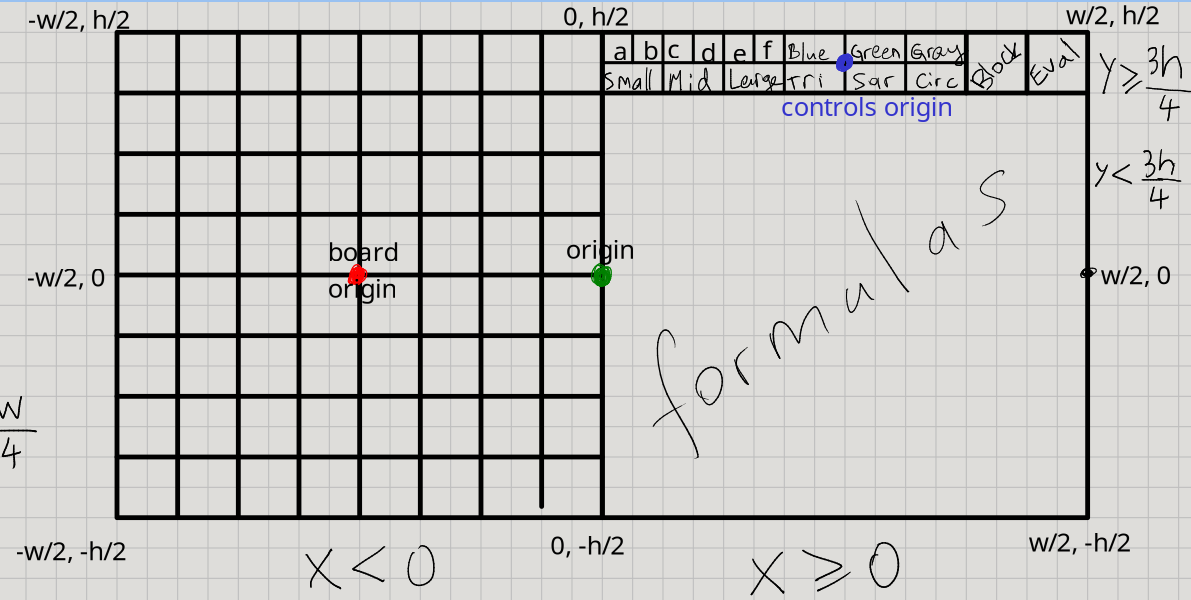
There is the origin of the entire UI, the origin of the chess board, and the origin of the top-right controls. In each case, the “button” click is checked by calculating from each respective origin. Horrible idea and design… but it will work for now, until I switch to a proper GUI library later.
Here are the grid positions:
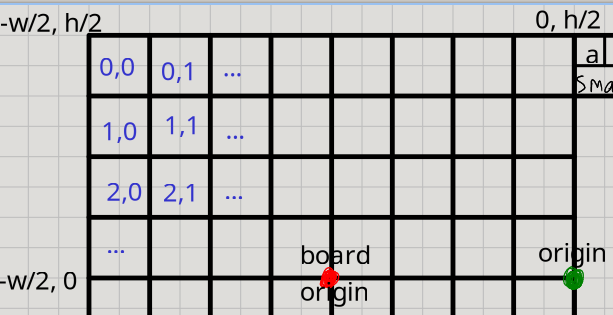

So there is a map between control buttons and grid positions:
val controlGrid = Map[String, Pos](
"Eval" -> (0, 0),
"Add" -> (0, 2),
"a" -> (0, 4),
"b" -> (0, 5),
"c" -> (0, 6),
"d" -> (0, 7),
"e" -> (0, 8),
"f" -> (0, 9),
"Blue" -> (0, 10),
"Green" -> (0, 11),
"Gray" -> (0, 12),
"Block" -> (0, 14),
"Move" -> (1, 0),
"Del" -> (1, 2),
"Small" -> (1, 4),
"Mid" -> (1, 6),
"Large" -> (1, 8),
"Tri" -> (1, 10),
"Squ" -> (1, 11),
"Cir" -> (1, 12)
)
This leads to the following click design:
(the converters are discussed further below)
def click(p: Point, world: World): World =
if p.x < 0 then
val pos = BoardConverter.toPos((p - BoardOrigin).toPoint)
handlePos(pos, world) // handle position / block changes on the Board
else if p.y > ControlsBottom then
val pos = ControlsConverter.toPos((p - ControlsOrigin).toPoint)
handleControls(pos, world) // handle the controls UI buttons
else world // do nothing for now
Converters
Given the model I decided on, I have to convert between grid positions (Int)
and arbitrary points on the plane (Double). This is a fairly common problem.
So there must be many well-made solutions out there. But of course, screw that!
I gotta do it from scratch.
Grid positions Pos and coordinate positions Point
The Point system of Doodle work as a Cartesian system centered at the origin.
The Grid system starts at the top-left, and grows to the right and bottom.
Point uses Double while Grid is integer only.
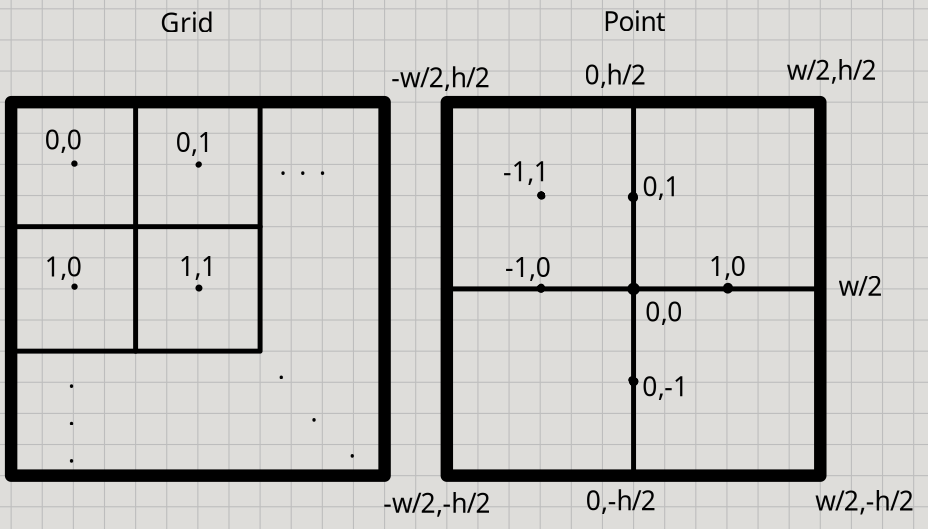
In this system, the left side has x coordinate equal to -width / 2, and
the top side has y coordinate equal to height / 2.
Converting from Pos to Point
This is the easier part.
The board has a width, a height, and numbers of rows and columns.
The height and width of an invidivial block can be calculated from those.
Then, a grid position will be the point that is at the center of the square it represents.
The 0.5 comes from this center (half of the square).
// blockWidth is boardWidth / numOfColumns
// blockHeight is boardHeight / numOfRows
// left is -width / 2, top is height / 2
extension (pos: Pos)
def toPoint: Point =
val x = left + (0.5 + pos.col) * blockWidth
val y = top - (0.5 + pos.row) * blockHeight
Point(x, y)
Converting from Point to Pos
This is harder since a Point is arbitrary and I cannot expect the user to click exactly
on the center of a square on the grid. So, anywhere on a square should count as the same.
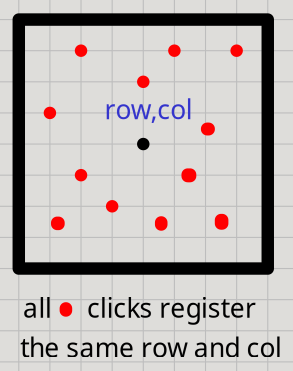
Fortunately, the Double to Int conversion will help with that! I can use the inverse
of the same formula from above, and the .toInt conversion acts like a floor function.
This way, all the x, y coordinates will round down to the same grid row and col:
extension (point: Point)
def toPos: Pos =
val row = (top - point.y) / blockHeight // -0.5 has to be excluded
val col = (-left + point.x) / blockWidth // -0.5 has to be excluded
(row.toInt, col.toInt)
Conditional givens, extension methods
It made sense to turn this conversion stuff into a trait.
Initially I decided to do it as an implicit typeclass instance, which provides
extension methods to Point and Pos which uses itself as an implicit parameter:
trait Converter:
val blockHeight: Double
val blockWidth: Double
val top: Double
val left: Double
extension (pos: Pos) def toPoint(using Converter): Point
extension (point: Point) def toPos(using Converter): Pos
This way, an implicit Converter instance would be provided at the beginning,
and all the .toPoint and .toPos methods would pick it up automatically,
without any annoying parameter passing down all over the place.
This is a very nice, elegant design.
However, the conversions depend on the board width, height, and the grid’s number of rows and columns, and these would have to be passed down everywhere too. So… we can make them implicit too! Then we can use Scala’s conditional givens. A conditional given consumes other givens as implicit parameters and produces a new given.
given (dims: Dimensions) => (gs: GridSize) => Converter:
From the board dimensions (width and height), and grid size (numbers of rows and columns), we can derive the height and width of a block, and the top / left of the board:
given (dims: Dimensions) => (gs: GridSize) => Converter:
val blockHeight: Double = dims.h / gs.rows
val blockWidth: Double = dims.w / gs.cols
val top: Double = dims.h / 2
val left: Double = dims.w / 2
// followed by the conversion extension methods from above
Converting conditionally with givens: an anti-pattern
This design was so beautiful and clever, it made me feel very smart! However, using it caused some friction, and made me notice an anti-pattern: trying to conditionally choose a given, among many givens of the same type, is painful! I have to use 3 different dimensions/grid sizes, and corresponding conversions:
object UIConverter:
given Dimensions = (h = Height, w = Width)
given GridSize = (rows = BoardRows, cols = BoardCols * 2)
object BoardConverter:
given Dimensions = (h = Height, w = Width / 2)
given GridSize = (rows = BoardRows, cols = BoardCols)
object ControlsConverter:
given Dimensions = (h = Height / 8, w = Width / 2)
given GridSize = (rows = ControlRows, cols = ControlCols)
def convertPointConditionally(p: Point): Pos =
if p.x < 0 then
import BoardConverter.given
Point(p.x - BoardOrigin.x, p.y - BoardOrigin.y).toPos
else if p.y > ControlsBottom then
import ControlsConverter.given
Point(p.x - ControlsOrigin.x, p.y - ControlsOrigin.y).toPos
else
import UIConverter.given
p.toPos
As you see, in order to avoid “ambiguous given instances” errors, I have to place each given in a separate object to put them in different scopes, then I have to manually import that particular object’s givens. Another problem is that this obscures the intent of the code for the reader.
The anti-pattern is: “don’t use givens if, a given does not apply generally and has to be selected conditionally among many givens of the same type.” Or more generally: “don’t make a given-based design if it’s getting too complicated.”
Deferred givens? No, just regular old parameters
There is a way to improve this a bit, using another advanced Scala feature: deferred givens
Instead of a conditional given, I could “lift” the Dimensions and GridSize givens
up into the Converter trait itself as abstract / unimplemented members:
trait Converter:
given dims: Dimensions
given gs: GridSize
// ... the rest of the trait
But abstract givens are being phased out / replaced by deferred givens (as mentioned in the documentation above):
trait Converter:
given Dimensions as dims = deferred
given GridSize as gs = deferred
// ... the rest of the trait
Then these have to be implemented by concrete instances:
object BoardConverter extends Converter:
given Dimensions = (h = Height, w = Width / 2)
given GridSize = (rows = BoardRows, cols = BoardCols)
Then it dawned on me… all this given mechanism is just redundant! Traits in Scala can accept parameters! 🤣 I totally forgot about that! If I give up on making everything implicit, and make them explicit instead, then:
trait Converter(dims: Dimensions, gs: GridSize)
Now the extension methods do not work because the trait is not a given instance; we have to use the conversion methods directly:
trait Converter(dims: Dimensions, gs: GridSize):
val blockHeight: Double = dims.h / gs.rows
val blockWidth: Double = dims.w / gs.cols
val top: Double = dims.h / 2
val left: Double = -dims.w / 2
def toPoint(pos: Pos): Point =
val x = left + (0.5 + pos.col) * blockWidth
val y = top - (0.5 + pos.row) * blockHeight
Point(x, y)
def toPos(point: Point): Pos =
val row = (top - point.y) / blockHeight // - 0.5
val col = (-left + point.x) / blockWidth // - 0.5
(row.toInt, col.toInt)
Ad-hoc (typeclass) vs. subtype (inheritance) polymorphism
Sometimes ad-hoc polymorphism is not a good fit for a solution, and instead a traditional, OOP subtyping is a much better fit. Generally we are told to prefer composition over inheritance, but this is one of those rare cases where inheritance is better.
I can define the parameters for each instance purely as constants, not givens:
val UIDimensions = (h = Height, w = Width)
val UIGridSize = (rows = BoardRows, cols = BoardCols * 2)
val BoardDimensions = (h = Height, w = Width / 2)
val BoardGridSize = (rows = BoardRows, cols = BoardCols)
val ControlsDimensions = (h = Height / 8, w = Width / 2)
val ControlsGridSize = (rows = ControlRows, cols = ControlCols)
then we just extend the trait!
object UIConverter extends Converter(UIDimensions, UIGridSize)
object BoardConverter extends Converter(BoardDimensions, BoardGridSize)
object ControlsConverter extends Converter(ControlsDimensions, ControlsGridSize)
Heck, we don’t even need a trait, just make it a case class, and instances:
case class Converter(dims: Dimensions, gs: GridSize):
// ...
object Converter:
val UIConverter = Converter(UIDimensions, UIGridSize)
val BoardConverter = Converter(BoardDimensions, BoardGridSize)
val ControlsConverter = Converter(ControlsDimensions, ControlsGridSize)
Now the conditional conversion logic is much simpler and the intent is clearer:
object Converter:
// ...
def convertPointConditionally(p: Point): Pos =
if p.x < 0 then BoardConverter.toPos((p - BoardOrigin).toPoint)
else if p.y > ControlsBottom then ControlsConverter.toPos((p - ControlsOrigin).toPoint)
else UIConverter.toPos(p)
Handlers
Handling board positions
Position handling on the board is tricky. Imagine the user clicks somewhere on the board. There are many situations:
- A position is not selected:
- in this case, simply select the clicked position.
- Update the block display if there is a block there.
- A position is already selected:
- The clicked position is the same as the selected position:
- then de-select it.
- Block display stays the same.
- The clicked position is different than the selected position:
- Move is enabled:
- The clicked position is empty:
- then move the block at selected position to the clicked position.
- Block display does not change (display the same block that is moved).
- The clicked position already has a block on it:
- in this case, moving is not possible.
- Then change the selected position to the clicked position.
- Update the block display to show the block at clicked position.
- The clicked position is empty:
- Move is disabled:
- then change the selected position to the clicked position.
- Update the block display if there is a block there.
- Move is enabled:
- The clicked position is the same as the selected position:
Handling controls
To handle controls, we need the reverse: a map from grid positions to controls:
val gridControl = Map[Pos, String](
(0, 0) -> "Eval",
(0, 1) -> "Eval",
(0, 2) -> "Add",
(0, 3) -> "Add",
(0, 4) -> "a",
(0, 5) -> "b",
(0, 6) -> "c",
(0, 7) -> "d",
(0, 8) -> "e",
(0, 9) -> "f",
(0, 10) -> "Blue",
(0, 11) -> "Green",
(0, 12) -> "Gray",
(0, 13) -> "Block",
(0, 14) -> "Block",
(0, 15) -> "Block",
(1, 0) -> "Move",
(1, 1) -> "Move",
(1, 2) -> "Del",
(1, 3) -> "Del",
(1, 4) -> "Small",
(1, 5) -> "Small",
(1, 6) -> "Mid",
(1, 7) -> "Mid",
(1, 8) -> "Large",
(1, 9) -> "Large",
(1, 10) -> "Tri",
(1, 11) -> "Squ",
(1, 12) -> "Cir",
(1, 13) -> "Block",
(1, 14) -> "Block",
(1, 15) -> "Block"
)
Notice that for the larger buttons, many grid positions can point to the same button.
Based on which control button is pressed, we delegate it to a helper method:
def handleControls(pos: Pos, world: World): World = gridControl.get(pos) match
case None => world
case Some(value) => // make sure a button is clicked
value match
case "Eval" => handleEval(world)
case "Add" => world.addBlockFromControls
case "Del" => world.removeBlockAt(pos)
case "Move" => world.toggleMove
case "Block" => world
case "a" | "b" | "c" | "d" | "e" | "f" => handleName(value, world)
case "Blue" | "Green" | "Gray" => handleColor(value, world)
case "Small" | "Mid" | "Large" => handleSize(value, world)
case "Tri" | "Squ" | "Cir" => handleShape(value, world)
Wrapping and forwarding
A lot of this handling involves updating the Controls instance inside World.
This is a bit annoying and repetitive.
We have to “penetrate” through many wrappers and forward the logic:
- first access
World - then access
ControlsinsideWorld- then, possibly, access stuff inside
Controls(likeBlock) - then update that stuff
- then update (copy)
Controlswith the new stuff
- then, possibly, access stuff inside
- then update
Controls - then update (copy)
Worldwith the new controls
This must be a very common problem, I wonder if there is a good solution?
View
View needs to:
- convert data to images:
Imager - put images together:
Renderer
Imaging
What are the things we need to convert to images?
- Blocks
- Formulas
- Evaluation results
Normally I would have preferred to keep these as .toImage methods in each class,
but for the sake of moving them out of Model and into View, I moved them out.
Note the union type, and how we can do an exhaustive pattern match against it:
package tarski
package view
object Imager:
import Shape.*, Result.*
type Obj = Block | FOLFormula | Result
def apply(o: Obj): Image = o match
case b: Block =>
val shapeImg = b.shape match
case Tri => Image.triangle(b.size, b.size).fillColor(b.color)
case Squ => Image.square(b.size).fillColor(b.color)
case Cir => Image.circle(b.size).fillColor(b.color)
Text(b.label).font(TheFont).on(shapeImg)
case f: FOLFormula => Text(f.toString).font(TheFont)
case r: Result =>
r match
case Ready => Text(" ?").font(TheFont).strokeColor(Blue)
case Valid => Text(" T").font(TheFont).strokeColor(green)
case Invalid => Text(" F").font(TheFont).strokeColor(red)
This makes sense; if we had more than one View, we could easily turn this into a
trait Imager with methods to be implemented. Then there could be multiple
implementations that draw blocks in a weird, bendy way for example, or display formulas
with different fonts or sizes, or use different symbols and colors for the results of
evaluating formulas, and so on. The only contract being that it needs to convert these
three types into images. So it’s left open for extension but closed for modification,
following the Open-Closed principle (O in SOLID).
Basic syntax coloring
I decided to add a little bit of color to the logical connectives:

It was fairly easy to implement, just add some logic to Imager:
def colorText(formula: String)(using c: Constants): Image = formula
.foldLeft(Image.empty): (img, char) =>
img.beside:
Text(char.toString)
.font(c.TheFont)
.strokeColor(char.toColor)
extension (c: Char)
def toColor: Color = c match
case '¬' => red
case '∧' => blue
case '∨' => green
case '→' => brown
case '↔' => brown
case _ => black
Going character by character then stitching all the images is not the best way, but it gets the job done! 😄
Rendering
Made a lot of progress on rendering the controls (currently they do nothing):

Rendering is less modular, since the UI has to be designed in a certain, fixed way. Following the design of the picture above, I have to:
- Place the board on the left half (at board origin):
- place the blocks on the board,
- place the selected position on the board.
- Place the controls and the formulas on the right half:
- place controls above formulas (at controls origin)
- place formulas under it (at formulas origin).
Main renderer
This lends itself to the following main rendering function:
def render(world: World): Image =
renderSelectedPos(world.controls.pos)
.on(renderBlocks(world.grid))
.at(BoardOrigin)
.on:
renderControls(world.controls)
.at(ControlsOrigin)
.on:
renderFormulas(world.formulas)
.at(FormulasOrigin)
Note that I am not using methods like .above, .below or .beside,
using .on instead because the parts of the board are drawn with respect to
Doodle’s Point origin at (0, 0), rather than relative to each other.
Normally .on could result in two overlapping images stuck on top of each other
(like using a decorative sticker on a surface), but since I’m using .at to place them
in correct positions, they don’t overlap.
View or Model? (again): state of the controls
One issue that came up is the “selected block on the board”. The selected block needs a red outline rendered around it (as you see above). There are also selected controls for color, shape, size, name, etc.
Should View keep its internal state for this? Or should it be in Model? By chance, I was watching a Tim Cain video where similar considerations came up. Tim’s approach is to let View keep its internal state:

It does make sense, because he is talking about a video game, with a much more complicated UI and model (game) state. This necessitates more complicated design, using the Observer pattern with events. But for me, where should I place the grid position of the “selected block”?
Initial approach: keep it in Model
I directly added it to my World class:
case class World(
grid: Grid = Map(),
blocks: Blocks = Map(),
names: Names = World.initNames,
formulas: Formulas = Map(),
selectedPos: Option[Pos] = None
)
Second attempt: the Controls class
Now I made a Controls class which keeps the state of all the controls:
- the grid position of the selected block on the board
- the selected color
- the selected shape
- the selected size
- the selected named object (
a,b,c,d,e,f) - whether moving a block is enabled or not
case class Controls(
size: Option[Double] = None,
shape: Option[Shape] = None,
color: Option[Color] = None,
name: Option[Name] = None,
move: Boolean = false
)
But… an instance of Controls is still included in World,
so it’s still part of the Model:
case class World(
grid: Grid = Map(),
blocks: Blocks = Map(),
names: Names = World.initNames,
formulas: Formulas = Map(),
controls: Controls = Controls(),
selectedPos: Option[Pos] = None // should this go INTO controls too?
)
Should I also include selectedPos in this Controls instance? Not sure.
Problems that arise by moving it from Model to View
If selectedPos is moved into View as its internal state,
then Controller has to get more complicated…
As you see above, Controller has functions that all return a World.
But now, these functions would have to update View’s state as a side effect,
then return the new World in a functional / immutable way.
Or, it would have to return a (World, View) pair… 🤮
Another issue is that, currently View is purely a renderer.
It just takes World data from Model and draws it, that’s it.
Adding state to it will complicate things further.
It will have to draw, and also have its state updated as a side-effect.
Or, return an (Image, View) pair… 🤮
Should Controls state be in… the Controller?
Another idea is to keep the Controls state in the Controller…
These decisions are hard! I’ll keep things in Model for now, and let’s see what happens.
Rotating the board
The original Tarski’s world has a feature that rotates the board 90 degrees. The companion book also has exercises that use this feature.
Now, normally this would be “a different view”, right? Data remains the same, and it’s just displayed differently. However… in this case it actually changes the semantics of the world, because the positions of the objects change! Therefore, any positional predicate like “a is above b” has to be re-evaluated. So… View or Model? It’s philosophical! strikes once again.
We have to update the board (Model, World) then render it.
Rotator class (has to go into Controller)
We need to calculate the 90 degree rotated positions. Even though the board will always be 8x8, I still wanted to make it size agnostic. Rows and columns are swapped, and one of them is “negated”.
case class Rotator(gs: GridSize):
def rotateLeft(pos: Pos): Pos = (row = gs.cols - pos.col - 1, col = pos.row)
def rotateRight(pos: Pos): Pos = (row = pos.col, col = gs.rows - pos.row - 1)
def rotate(dir: String): Pos => Pos = dir match
case "Left" => rotateLeft
case "Rgt" => rotateRight
object Rotator:
def board = Rotator(BoardSize) // Rotator instance for the 8x8 board
Also had to update View with some new buttons:

You can see it in action in the video at the top of the page.
Adding package boundaries to find dependency problems
So far everything is inside one big package tarski. Now I add packages for controller,
view, model, main and testing to see what needs to be imported.
This will also expose how the components are coupled and communicate with each other.
But I’d like to avoid having too many imports everywhere.
Dependency tree
I’d like it to be like so:
// main
// |
// view testing
// | /
// controller
// |
// model
// |
// constants
Package declarations
Maybe it’s a good idea to have a package.scala for each package,
and export all the necessary imports, inside that package,
to avoid repeating all the imports? So far the imports are very few, so it’s unnecessary.
No, I will go with this idea. It’s nice to eliminate annoying imports.
Initially I added a package.scala with exports in each folder.
Then I decided to place them all in one “main” file.
Here I am using package declarations in a way literally no one else does in Scala.
Notice the actual : and indentation following the package declarations:
package tarski:
// project-wide imports of third-party libraries, as exports. For example:
export cats.effect.unsafe.implicits.global
export doodle.core.{Color, Point, OpenPath}
export gapt.expr.stringInterpolationForExpressions
// ... more of that...
// project-internal imports from one package to another, as exports
package view:
export model.{Grid, World, Shape, Block, Result, Formulas, Controls}
export Shape.*, Result.*
export controller.Converter.BoardConverter
package controller:
export model.{Pos, Blocks, Grid, GridSize, World, Shape}, Pos.*, Shape.*
package testing:
export model.{World, Grid, Shape, Block, Blocks, Status}, Status.*, Shape.*
export controller.{eval, Converter}, Converter.*
package main:
export model.{World, GridSize, Block, Shape}, Shape.*
export view.Renderer.*
export controller.{tick, click, move, stop}
This is a very elegant solution for me, which I think would be unacceptable in industry.
There are no imports anywhere anymore, and everything is in one place.
It’s nice since it is a small personal project.
In a large project with multiple people working on it, this would be a no-no,
since imports at the top of a file tell programmers where things come from.
Also, exports cause namespace pollution and run the risk of name collisions.
One limitation I found is that exports don’t work with packages and with Java stuff.
If we try to export a package Scala gives us an error: “Implementation restriction”.
So it makes logical sense, but is restricted for reasons.
There are ways around it, like wrapping things with objects and then exporting that.
But that defeats the purpose, so I’ll live with one or two imports.
Moving from Doodle to ScalaFX, proper UI
TODO
Exposing the library to users
In an educational setting, the students will be given:
- a grid (blocks placed on grid positions)
- possibly empty, the students might have to place the blocks themselves
- a list of formulas
- possibly empty, the student might have to write the formulas themselves
and then asked to run the program.
I also have to take screen sizes into account (see below) with a scaling factor. Therefore:
package tarski
package main
// ...
// Need to figure out a way to scale the graphics, somehow!
def run(grid: Grid, formulas: Seq[FOLFormula], scaleFactor: Double = 1.0) =
val world = World(grid = grid, formulas = Formulas.fromSeq(formulas))
Reactor
.init[World](world)
.withOnTick(tick)
.withRender(render)
.withOnMouseClick(click)
.withOnMouseMove(move)
.withStop(stop)
.withTickRate(TickRate)
.animateWithFrame(MainFrame)
Issue with smaller screen sizes
Currently everything is designed with global constants.
Screen size, font size, the blocks, everything flows from one constant Size.
It is set to 100.0, which makes the UI size 1600x800 by default.
What if people are using Tarski on lower resolutions? Such as the popular 1366x768 resolution present in many laptops? Then the UI won’t fit onto their screens!
Now, we can simply change the Size value and all other values will adjust.
In fact I tested this, and not only everything looks reasonable, but works too:
This one is quarter the size of the default, it’s 800x400:

So the Size value has to be adjustable by the user.
We have dozens of constants, which depend on one constant, which needs to change.
If I change Size from a val to a def, I get close to 50 compiler errors! 😱
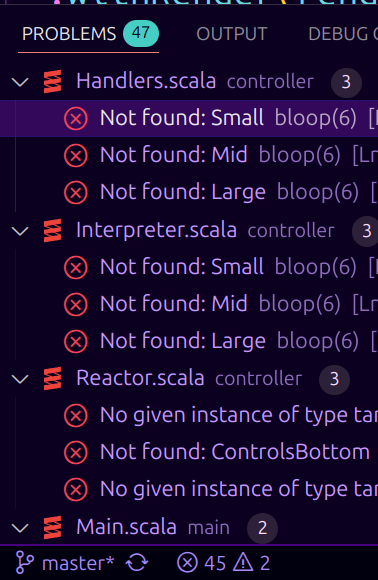
It’s not just the constants that depend on Size.
All the modules (model, view, controller, testing, main) depend on these constants.
So the Size has to be passed down to ALL of them!
This means adding a parameter in 50 different places!
For example, the Converter above depends on Dimensions which are derived from Size.
Also anything that depends on Small, Mid, Large sizes depend on Size.
This includes not only View components like Imager and Renderer, but even the Interpreter!
This is quite a difficult problem to solve.
Of course if I simply accept the boilerplate and the bloat, it IS solvable. But I’d like to try keeping boilerplate to a minimum.
First approach: make Size a given, then use conditional givens
In this approach, various things that depend on Size will be derived from it.
For example, if Converter needs Dimensions, it will be a conditional given.
Or if Imager needs Small/Mid/Large then it will be a given derived from Size.
package tarski
package constants
opaque type Size = Double
given Size = 100.0
This requires passing it everywhere as a using parameter:
def StrokeW(using size: Size) = size * 0.08
def Pts(using size: Size) = size * 0.25
def Height(using size: Size) = size * 8.0
def Width(using size: Size) = Height * 2.0
def Small(using size: Size) = size * 0.4
def Mid(using size: Size) = size * 0.7
def Large(using size: Size) = size * 0.95
def SmallStroke(using size: Size) = StrokeW * 0.25
def UIBottom(using size: Size) = Height * 0.375
// ... many more
Then conditional givens in various places where it’s needed:
given Size => BoardDimensions =
(s: Size) =>
(h = constants.Height, w = constants.Width * 0.5)
given Size => UIDimensions =
(s: Size) =>
(h = Height * 0.125, w = Width * 0.5)
The disadvantages are:
- lots of
using Sizeeverywhere - lots of conditional givens
- lots of implicits can make things hard to understand
- potential issues of clashing with other implicits
Second approach: change Size to use an implicit ScaleFactor
def Size(using scaleFactor: Double) = 100.0 * scaleFactor
This is really not much of an improvement over the previous one. Kicking the can down the road, so to speak. Same issues.
Understanding the problem a bit better
This is an interesting design problem; we have tons of constants which all depend on one variable, and even the variable itself doesn’t change once it is set. So there will never be more than one instance of this variable…
A “singleton object with an implicit parameter”?
What we really need is a singleton object!
We want to reduce the (using ...) that is plastered everywhere 50 times.
But… unfortunately singleton objects cannot take parameters (explicit or implicit):
// not legal in Scala
object Constants(using size: Double):
// ... stuff goes here
So, is a traditional class approach the only way?
Third approach: create a Constants class
case class Constants(size: Double):
val StrokeW = size * 0.08
val Pts = size * 0.25
val Height = size * 8.0
val Width = Height * 2.0
// ...
// basic shapes
val SmallSq = Image.square(Pts)
val Sqr = Image.square(size)
val WhiteSq = Sqr.fillColor(white)
val BlackSq = Sqr.fillColor(black)
// ...
val MainFrame = Frame.default
.withSize(Width, Height)
.withBackground(BgColor)
.withTitle(Title)
.withCenterAtOrigin
The downsides are:
- still having to pass around
(using Constants)everywhere (more on that below) - the intent is obscured a bit: there shouldn’t be multiple instances of this class!
A trick: singleton object plus extension methods
There IS a way to avoid this class approach: a singleton object plus extension methods.
The key part of the trick is the type of the singleton object: Constants.type.
object Constants
extension (c: Constants.type)(using s: Size)
def StrokeW = size * 0.08
def Pts = size * 0.25
def Height = size * 8.0
def Width = Height * 2.0
// ... many more
This avoids plastering (using ...) everywhere, thanks to bulk extension syntax.
Just only one at the top, like the class approach.
I did think about extension methods, but Constants.type would have never occurred to me.
I found it by asking the community for advice.
This made importing / exporting a bit cumbersome. In this approach, both the object and the extension methods have to be imported by their own individual names, like
import tarski.constants.Constants
import tarski.constants.StrokeW
rather than the name of the object followed by the method, like
import tarski.constants.Constants.StrokeW
or rather than just importing Constants then using Constants.StrokeW.
There is a way around that too: place the extension methods directly in the object:
object Constants:
extension (c: Constants.type)(using size: Double)
def StrokeW = size * 0.08
def Pts = size * 0.25
def Height = size * 8.0
def Width = Height(c) * 2.0
// ... many more
Notice how Height is called: it’s NOT c.Height (errors) but Height(c).
The downsides are:
- extensions do not allow
val, they have to bedef. So, the same CONSTANTS will have to be re-evaluated many times… - we cannot span this across multiple files.
Too many extension methods
This works fine for the Constants.
However it does not work for other parts of the code, such as the Renderer.
The biggest problem is this: I have TOO MANY methods which need to be split
into multiple files. The object Renderer: definition cannot span multiple files!
For each file, I would have to use a different singleton object.
Or, extension methods would be outside the object,
and I’d have to accept the downsides of importing / exporting.
Also, this is getting a bit too roundabout and convoluted for my taste. It complicates things and obscures the intent a bit too much.
Final approach: use a combination of approaches
Finally I went with the class approach, but still using the extensions in some places.
If I have too many vals, and I don’t want them re-evaluated, use the class.
If def is OK and the scope is small (one file), then go with extensions.
For example, I have the UI grid mapping from before.
The object / extension trick lets me clean up a lot of (using ...) clauses,
without defining a class (which would have only 1 instance, ever):
Before:
def evalPt(using Constants) = ControlsConverter.toPointShiftX(controlGrid("Eval"))
def movePt(using Constants) = ControlsConverter.toPointShiftX(controlGrid("Move"))
// many more...
def bluePt(using Constants) = ControlsConverter.toPoint(controlGrid("Blue"))
def greenPt(using Constants) = ControlsConverter.toPoint(controlGrid("Green"))
// many more...
def blockPt(using Constants) = ControlsConverter.toPointShiftY(controlGrid("Block"))
After:
object UI
extension (uio: UI.type)(using Constants)
def evalPt = Converter.ui.toPointX(UIGrid("Eval"))
def movePt = Converter.ui.toPointX(UIGrid("Move"))
// many more...
def bluePt = Converter.ui.toPoint(UIGrid("Blue"))
def greenPt = Converter.ui.toPoint(UIGrid("Green"))
// many more...
def blockPt = Converter.ui.toPointY(UIGrid("Block"))
This is very nice! 🥳
Note that I intended to use these as UI.evalPt etc.,
so the importing downside does not matter here.
The val downside is not relevant either, since these all have to be defs anyway.
Silly fun with different rows and columns
Just for silly fun, I also made it so that the number of rows and columns are adjustable, although this will never be used:

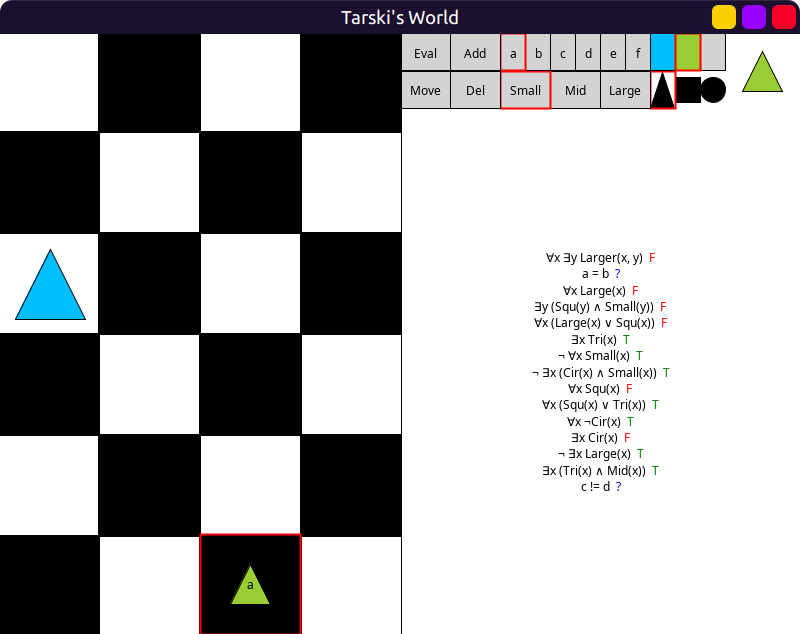

Obviously, some items (formulas, block display) won’t fit in this case! 😆
Import / export issues
Since students need the grid, the formulas and the ability to run it, they need to import:
- the ability to code blocks:
BlockShapeSizedoodle.core.Color
- the ability to code FOL formulas:
gapt.expr.formula.fol.FOLFormula- also the string interpolators
gapt.expr.stringInterpolationForExpressions
- the ability to run:
doodle.reactor.Reactor
To minimize students’ importing effort, I placed them all into a module,
tarski.main and bulk exported them, so they can simply use: import tarski.main.*.
Font issues
I noticed that most fonts available to Doodle cannot show all logical symbols correctly, or they don’t look very nice. When it does look nice and displays everything right, I could not be sure if users would have the same fonts on their systems as I do. So I started testing one of my releases in a virtual machine where I uninstalled all the fonts that I could without breaking the OS completely. Here are some examples:
This is the default Sans Serif font, the quantifiers look weird and the title is missing:

This is the default Serif font, the title is missing again (because I uninstalled all fonts):
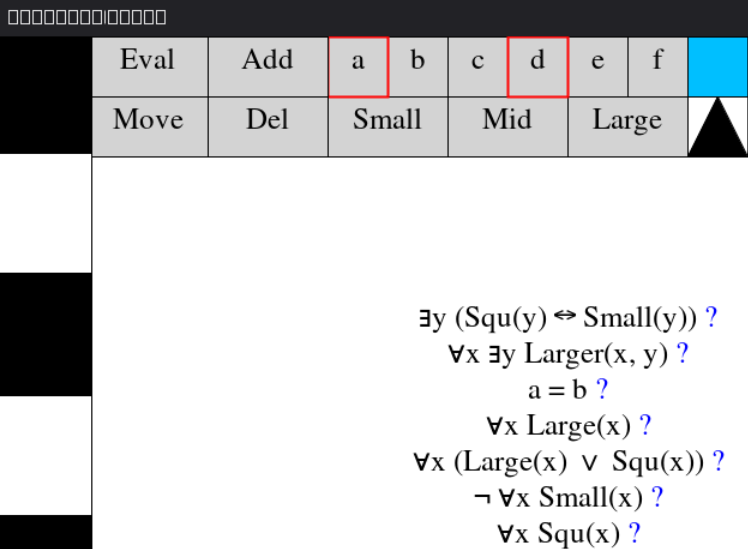
This is Segoe UI, it’s missing the quantifiers:
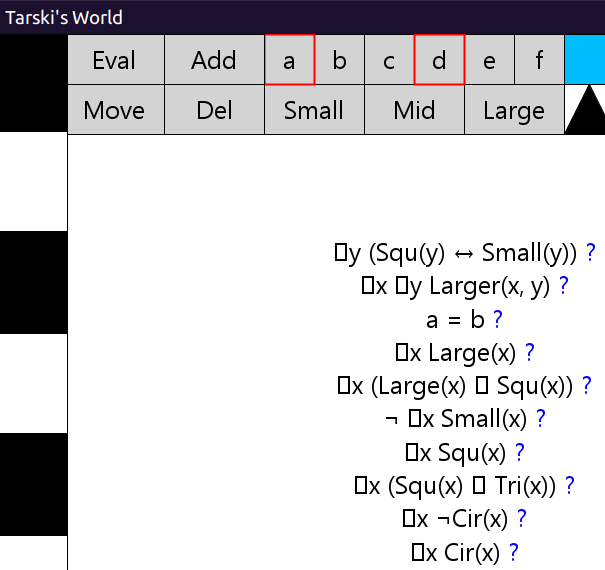
This one looks good, except it’s missing the biconditional symbol ↔.
It’s missing on the first, topmost formula right after Squ(y):
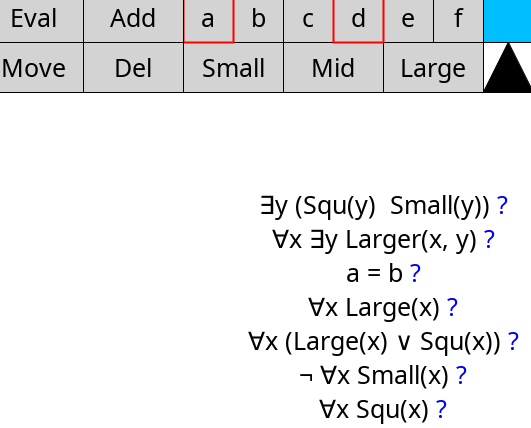
It just so happens that DejaVu Sans is free and can be included in a project. So I had to figure out how to bundle it into my releases.
Bundling the font
It worked fine on my own file system when loaded via:
val FontFile = java.io.File("font/DejaVuSans.ttf")
I accidentally released this, it does not work for users… so I have a broken release! 😆
Noel Welsh helped me out a lot with this on Discord. This is the documentation for bundling a font with the application: Oracle docs
The font has to be loaded, derived, then registered with the graphics environment. That’s the only way it’s available without relying on OS fonts. If any of these steps is missing, it will fall back on an OS font, and look wrong.
For the class loader to find it, it cannot be a java.io.File like above,
but has to be an InputStream coming from the resources directory instead.
That way, it can work on users’ machines:
// Load the file
val FontFile = getClass.getResourceAsStream("/DejaVuSans.ttf")
// Create a font object then derive the font
val FontFromFile = java.awt.Font.createFont(java.awt.Font.TRUETYPE_FONT, FontFile)
val DerivedFont = FontFromFile.deriveFont(Pts)
// Register it with the graphics environment
val ge = java.awt.GraphicsEnvironment.getLocalGraphicsEnvironment()
ge.registerFont(DerivedFont)
// Finally, pass it to Doodle
val Family = DerivedFont.getFamily()
val TheFont = doodle.core.font.Font(
FontFamily.named(Family),
FontStyle.normal,
FontWeight.normal,
FontSize.points(Pts)
)
The getResourceAsStream("/DejaVuSans.ttf") here was a nightmare to work with.
It took a ton of searching online and reaching out on Discord to finally nail down
the correct syntax. I even spent hours step-debugging .createFont. It wasn’t:
resources/DejaVuSans.ttf/resources/DejaVuSans.ttf./resources/DejaVuSans.ttfDejaVuSans.ttf./DejaVuSans.ttf
but it was /DejaVuSans.ttf instead… 😠 💢
It was throwing a very unhelpful exception Problem reading font data. What?
Lots of searching online, lots of bug reports, and the authors said that the real reason
for the crash is deliberately hidden for security reasons:

Then we need to tell Scala-cli to find it:
//> using resourceDir ./font
and place it in the root directory of the project as ./font/DejaVuSans.ttf,
along with its license file (required). Finally done!
This is DejaVu Sans bundled and loaded correctly on the VM, this is what we want!
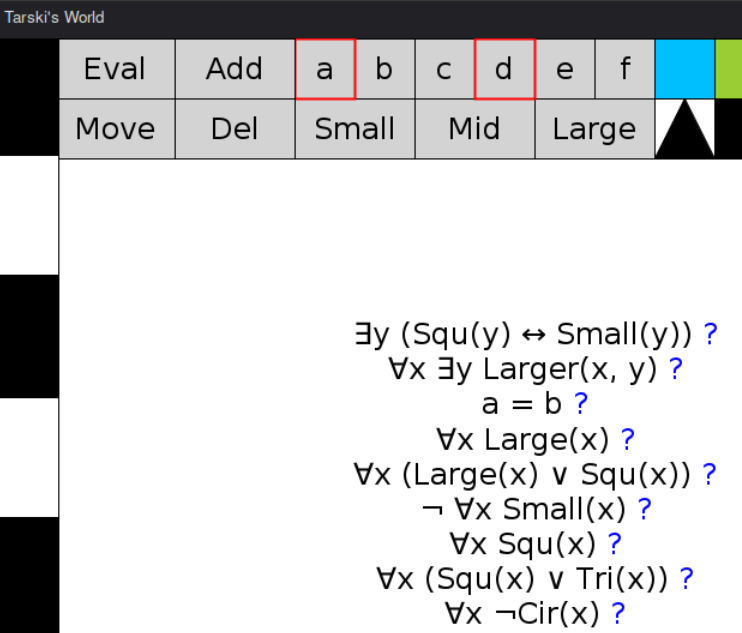
Finally releasing the damn thing into the wild
Here comes the scary part! 😱
Adding library ScalaDoc comments
To have nice documentation inside an IDE for users of the library, we need to add comments. They need to follow a certain format, but this is handled nicely by my IDE:

That generates a description to be filled in, and the parameters:
/**
* PUT STUFF HERE
*
* @param grid and here
* @param formulas and here
* @param scaleFactor and here...
*/
def runWorld(grid: Grid, formulas: Seq[FOLFormula], scaleFactor: Double = 1.0) =
I went through everything in my repository and added comments. Lots of boring work.
Generating documentation to be uploaded to javadoc.io
Upon publishing to Maven, the generated doc.jar will be picked up by
Javadoc in a few hours. To make sure everything was OK,
I generated docs locally with:
❯ scala doc . -f
Compiling project (Scala 3.7.4, JVM (24))
Compiled project (Scala 3.7.4, JVM (24))
Flag -classpath set repeatedly
1 warning found
Wrote Scaladoc to ./scala-doc
Doc comments can have links inside double brackets to link to other modules or objects:
/** Default numbers of rows and columns of the board. Used in [[controller.Converter]]. */
val BoardSize = (rows = BoardRows, cols = BoardCols)
If the contents of a link such as [[controller.Converter]] are wrong, the scala doc
command will give an error. So I make sure all of them are correct and can be found.
Project name and versioning
To publish easily in an automated way, we have to stick to semver,
and we need to stick to a default name format io.github.<username>.<projectname>.
For each version, we need a corresponding Git tag.
❯ git tag --sign v0.1.0
❯ git tag --verify v0.1.0
❯ git push origin v0.1.0
There are also snapshot versions that serve as a “safety net” before you commit
to the actual release, just in case there are some last minute bugs.
You just follow the tag with -SNAPSHOT, like: v0.1.0-SNAPSHOT.
Github releases
Then you have to push the tag, just like a commit, except it does not push any code. When you push a tag, it will appear on your Github page, which then you can “upgrade” to a proper release:
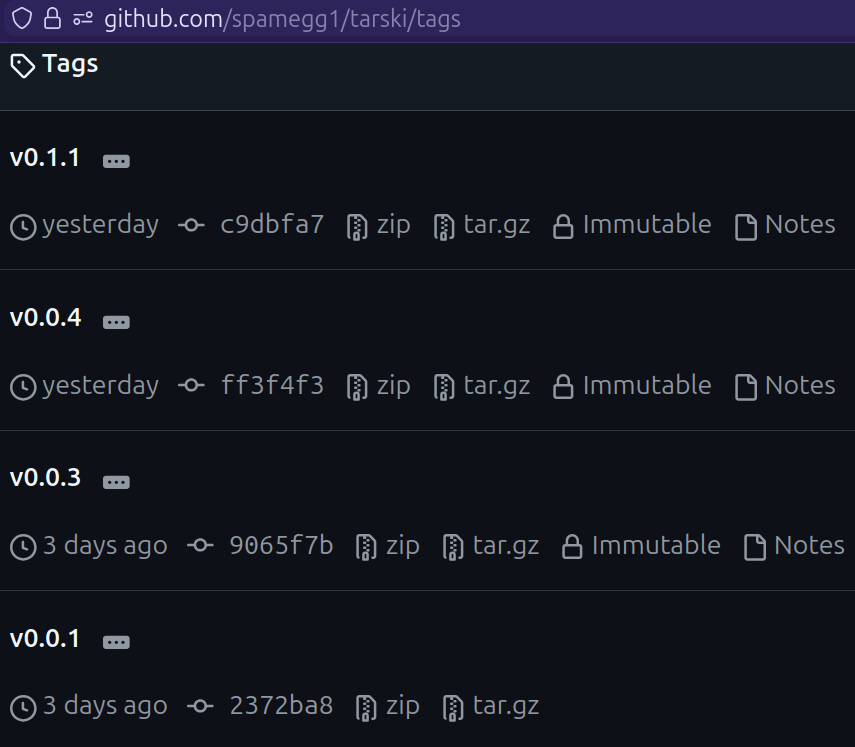

Local publishing
For safety, first you can publish locally:
❯ scala config power true
❯ scala publish local .
It will ask you for required info.
You can provide them in project.scala as using directives (see below).
This will place a SNAPSHOT release in ~/.ivy2/local/io.github.spamegg1/tarski_3.
Releasing artifacts to Maven with Scala-cli
This is the awful, painful part. Someone on Discord likened it to a colonoscopy. 🤮
There is a very long and complicated guide on Scala website. It does not help that this is all focused on SBT and its plugins.
There are 4 secrets you have to set up on your repository:

You also need to setup an account with Sonatype, and reserve a namespace. Thankfully this is significantly simplified if you just use your Github account. You get an automatically verified namespace:


Then you need to provide Scala-cli the necessary information:
//> using publish.organization io.github.spamegg1
//> using publish.name tarski
//> using publish.license Apache-2.0
//> using publish.computeVersion git:tag
//> using publish.developers "spamegg1|Spamegg|https://github.com/spamegg1"
//> using publish.url https://github.com/spamegg1/tarski
//> using publish.vcs github:spamegg1/tarski
//> using publish.repository central
//> using publish.user env:SONATYPE_USERNAME
//> using publish.password env:SONATYPE_PASSWORD
//> using publish.secretKey env:PGP_SECRET
//> using publish.secretKeyPassword env:PGP_PASSPHRASE
I had a lot of issues with the GPG signing. Scala-cli does not import your GPG key. I reached out on Discord, Anton Sviridov helped out with his import script which fixed the issue.
No matter how hard I tried, I could not make the GPG signing work. Something like this does not work:
//> using publish.gpgKey A467BFB403160D9F
Eventually I gave up on that, so I think Scala-cli now uses the default signing with Bouncy Castle. Not sure 🤷
Automating releases with Github Actions
I already had a Github workflow for any code push, which checks formatting and runs tests.
So I had to make sure that publishing does not happen with every push.
There is a way to do that: use the tag: property to trigger a workflow only when
the push has a certain tag that starts with v:
on:
push:
tags:
- v*
jobs:
publish:
runs-on: ubuntu-24.04
steps:
- uses: actions/checkout@v6.0.0
with:
fetch-depth: 0
- uses: coursier/cache-action@v7.0.0
- uses: VirtusLab/scala-cli-setup@v1.10.1
- run: |
./.github/workflows/import-gpg.sh
scala-cli --power publish .
env:
PGP_PASSPHRASE: $
PGP_SECRET: $
SONATYPE_PASSWORD: $
SONATYPE_USERNAME: $
This requires TWO workflow files; in my regular format and check workflow,
I need to use the opposite of this, and ignore any tags that start with v.
Notice there is no GPG importing or publishing here:
on:
push:
branches:
- master
tags-ignore:
- v*
jobs:
test:
runs-on: ubuntu-24.04
steps:
- uses: actions/checkout@v6.0.0
with:
fetch-depth: 0
- uses: coursier/cache-action@v7.0.0
- uses: VirtusLab/scala-cli-setup@v1.10.1
- run: scala-cli --power format --check && scala-cli --power test .
Companion repository
I started writing some exercises on a companion repository.
This repository is a user of the library; students are meant to clone it to their own machines and run it in VS Code or IntelliJ to work through the exercises.
Dogfooding is great
This made me become a user of my own library, i.e. it made me eat my own dog food. Because I have to import my own library, so it has to be available on Maven:
//> using dep io.github.spamegg1::tarski:0.1.1
Of course I could use my locally published version, but I wanted to get a feel for the end-user experience to see if everything would work on someone else’s machine.
And boy, was it a good idea! Within just 3 examples, I discovered a few bugs already:
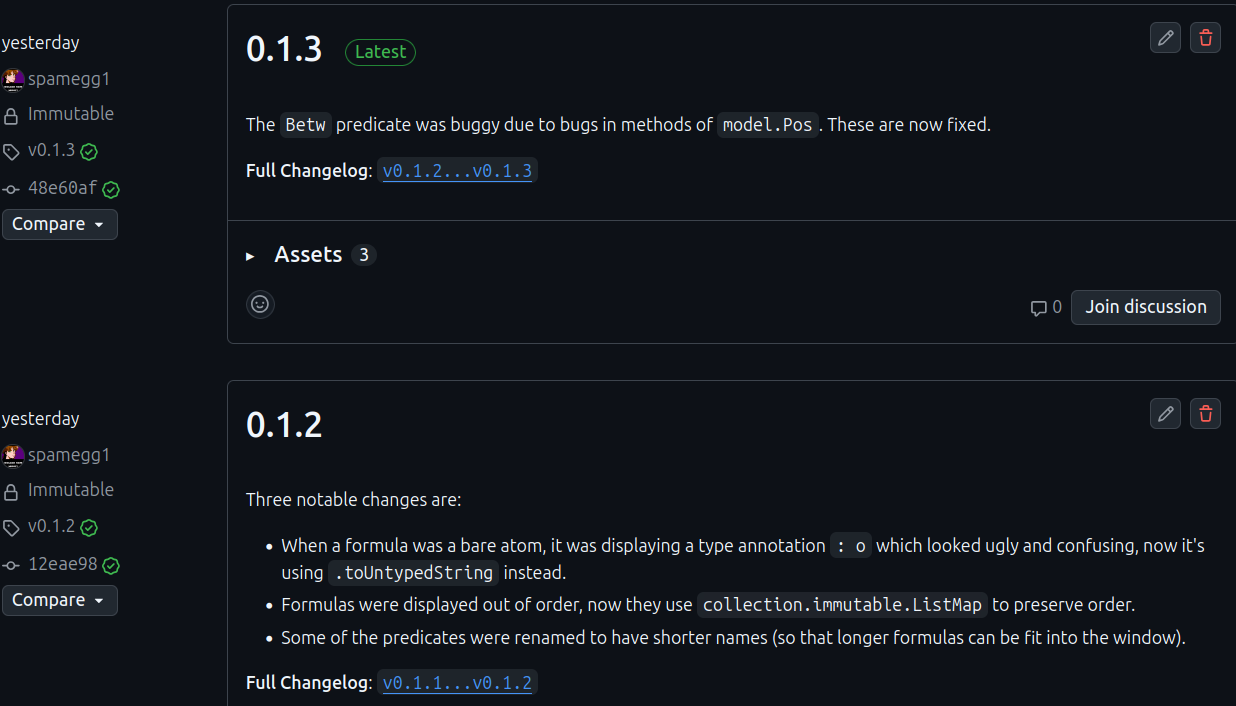
One of these bugs was severe; the implementation of the Between predicate was all wrong.
What’s next
I recently became aware of “Hyperproof”, a way to write proofs by using visual diagrams. There is a book for it, but no online tool yet that I can explore and reverse-engineer. 😏
For example, your proof can have regular premises like Small(a) → Green(a),
but it can also have pictorial info that, for example, shows that
a block is behind another, or a block has a certain shape, etc.
This is a very clever way to extend Tarski’s world and solve a common educational problem: proofs are always taught way too syntactically and as “meaningless symbol pushing”. I would love to do this! They said that Hyperproof will eventually get a web release. I just have to wait a few more years… 😆 Hey, I got time!
Work in progress
Stay tuned!